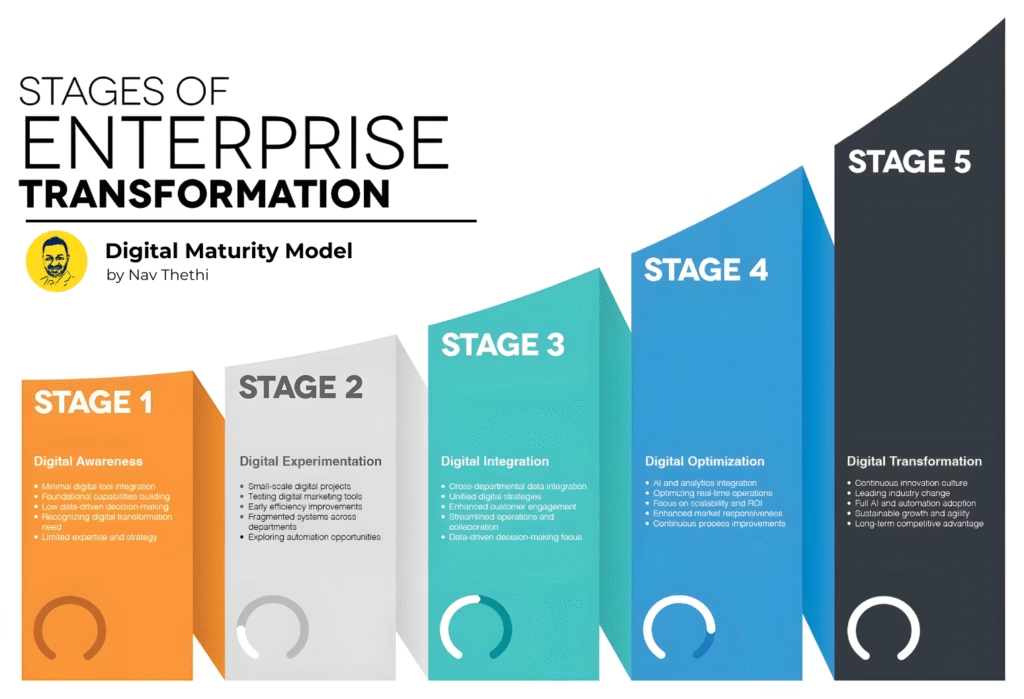
Digital Maturity
Unlock your enterprise growth with the comprehensive digital maturity model.
In today’s fast-paced digital landscape, staying competitive requires more than just adopting a few digital tools. Many businesses have taken steps toward digitization, whether through basic automation or digital marketing strategies, but few have truly mastered digital maturity. Digital maturity refers to how well an organization integrates digital technologies, data-driven insights, and customer-centric innovations.
Achieving digital maturity isn’t just about using new technology, it’s about evolving the entire business strategy to drive growth, enhance customer satisfaction, and maintain a competitive edge.
Why Digital Maturity Matters?
The ongoing digital initiatives and rapid development of digital technologies have transformed how businesses operate. From artificial intelligence (AI) to cloud computing, these innovations have the potential to streamline operations, improve decision-making, and enhance customer experiences. However, adopting these tools without a clear strategy or long-term vision often leads to inefficiencies and missed opportunities. This is where the concept of digital maturity comes in.
Businesses with high levels of digital maturity are not only equipped to adopt new technologies. Still, they can fully integrate these technologies, ensuring you align all that with their business objectives in your digital transformation journey. This enables companies to:
- Improve Operational Efficiency By Automating Processes And Eliminating Redundancies.
- Enhance Customer Experiences Through Personalization And Omnichannel Engagement.
- Make Data-Driven Decisions That Allow For Greater Agility And Innovation.
- Scale More Effectively, Ensuring That Growth Initiatives Are Sustainable And Aligned With Long-Term Goals.
- Stay Ahead By Responding Quickly To Market Changes And Technological Advancements.
Despite the clear benefits, many businesses struggle to achieve digital maturity. According to industry research, while most organizations have implemented some form of digital transformation, only a small percentage are truly mature in their approach. Companies that fail to embrace digital maturity fully often face challenges such as fragmented systems, inefficiencies, and the inability to leverage data for strategic decision-making.
Self-Assessment Questionnaire
Assess yourself if your business is truly leveraging digital transformation to its full potential, or are you just scratching the surface?
Here’s the checklist that can help you evaluate your digital transformation efforts. By considering factors like technology integration, data utilization, customer engagement, scalability, and innovation culture, organizations can determine if they’re genuinely maximizing the potential of digital maturity.
- Technology Integration: Are We Using Advanced Tools Like AI, Automation, And Analytics Across All Departments?
- Data Utilization: Are We Making Data-Driven Decisions That Enhance Operational Efficiency And Customer Experience?
- Customer Engagement: Are We Providing Personalized, Seamless Experiences Across Digital Touchpoints?
- Scalability: Can Our Current Digital Strategy Grow With The Business And Adapt To Market Changes?
- Innovation Culture: Does Our Company Foster Continuous Innovation And Encourage Upskilling For Digital Proficiency?
- Leadership Alignment: Is Our Leadership Fully Committed To Driving And Supporting Digital Transformation Initiatives?
The Digital Maturity Model
A Path to Success
This Digital Maturity Model provides companies with a roadmap for achieving digital maturity to maximize business value. By breaking down the journey into five distinct stages, the model helps companies understand where they currently stand and what steps they need to take to reach full maturity.
Let’s explore each stage in detail:

Stage 1: Awareness
At the Digital Awareness stage, businesses acknowledge the significance of digital tools but have not yet fully integrated them into their operations. Typically, companies in this stage rely on a basic technology stack to support manual processes, with digital efforts often siloed in specific departments. The primary focus is building foundational digital capabilities and developing a strategy for future growth. However, business challenges such as a lack of integration, reliance on manual processes, and limited use of data can hinder progress. The opportunity at this stage lies in laying the groundwork for future success by identifying key areas where digital transformation can add the most value across business units.
Stage 2: Experimentation
At this stage, businesses start experimenting with digital tools and strategies across various departments, often running pilot projects in digital marketing, digital experiences, automation, and data analytics. While these efforts can result in early efficiency gains, they tend to remain fragmented and lack scalability. The key focus is on testing digital solutions and experimenting with small-scale projects. However, fragmented systems and a lack of department alignment can limit progress. The opportunity lies in using these early experiments to identify successful initiatives that can be scaled across the organization for more significant impact.
Stage 3: Integration
Once businesses recognize the value of digital transformation, they advance to the Digital Integration stage, where digital technologies are fully integrated across departments, and data is leveraged to make informed decisions. This stage is marked by enhanced cross-departmental collaboration, improved customer engagement, and streamlined operations. The key focus is aligning digital efforts with broader business goals and using combined data sets to drive decision-making. While challenges such as overcoming data quality issues and silos and ensuring digital strategies are aligned across the enterprise remain, the opportunity lies in achieving greater efficiency by integrating digital tools throughout the organization and ensuring all teams work under a unified strategy.
Stage 4: Optimization
Digital transformation becomes a critical element of a company’s strategy. Businesses utilize advanced tools like real-time analytics, AI, and machine learning to optimize operations and enhance customer experiences. The focus is on refining processes to maximize efficiency and agility, bring the best results, and maximize return on investment (ROI). While challenges such as keeping pace with rapidly evolving technology and the need for continuous process optimization remain, significant opportunities exist to drive growth by leveraging data-driven insights, automating processes, and enhancing customer engagement.
Stage 5: Transformation
In the final stage of a company’s digital maturity, businesses fully embrace digital transformation, cultivating a culture of continuous innovation. At this point, digital tools and strategies are deeply embedded into daily operations and track progress, positioning the company as a leader in its industry. A solid commitment to ongoing innovation marks this stage as rapid adaptation to new technologies and a focus on sustainable growth. The key focus is maintaining a culture of innovation and leveraging digital tools to drive industry leadership. Challenges include ensuring continuous improvement and retaining leadership in a constantly evolving market. However, the opportunity to drive sustainable growth is significant by staying at the forefront of technological advancements and continuously refining digital strategies.
Trusted by top-notch companies
















The views and offerings on this website are my own and I do not represent or reflect those of any other brands.
The Business Impact of Digital Maturity
The Digital Maturity Model provides a clear framework for businesses to assess their current level of digital maturity and take actionable steps to improve.
Competitive Digital Advantage
Advancing digital maturity enables through automation, analytics, and innovation, enabling faster decisions, adaptability, and leadership.
Boost Operational Efficiency
Digitally mature companies streamline workflows, automate tasks, and scale efficiently, improving productivity, reducing costs, and boost performance.
Data-Driven Decisioning
Turning data into actionable intelligence enhances agility, strengthens forecasting, and empowers smarter, faster, evidence-based business decisions.
Sustainable Growth Agility
Embedding innovation and adaptability enables continuous improvement, long-term growth, and resilience in fast-changing digital environments.
Customer Experience Excellence
Mature organizations deliver seamless, personalized experiences, strengthening engagement, loyalty, and profitability through connected, omnichannel journeys.
Ethical Digital Trust
Responsible AI, inclusivity, and data integrity build lasting trust, reduce risk, and make ethics a competitive differentiator in the digital age.
Take the Step Forward Towards Digital Excellence Roadmap
Accelerate Your Path to Digital Excellence
To move from ambition to execution, explore The Digital Maturity Executive Advisory Program. This guide helps leaders assess readiness, design a maturity roadmap, and unlock sustainable business performance through strategic transformation.
Enable and Empower Your Teams
Build the capabilities your teams need to thrive in the digital era. The Digital Maturity Enablement & Corporate Training Program equips professionals with the frameworks, tools, and insights to accelerate transformation and lead with confidence.
